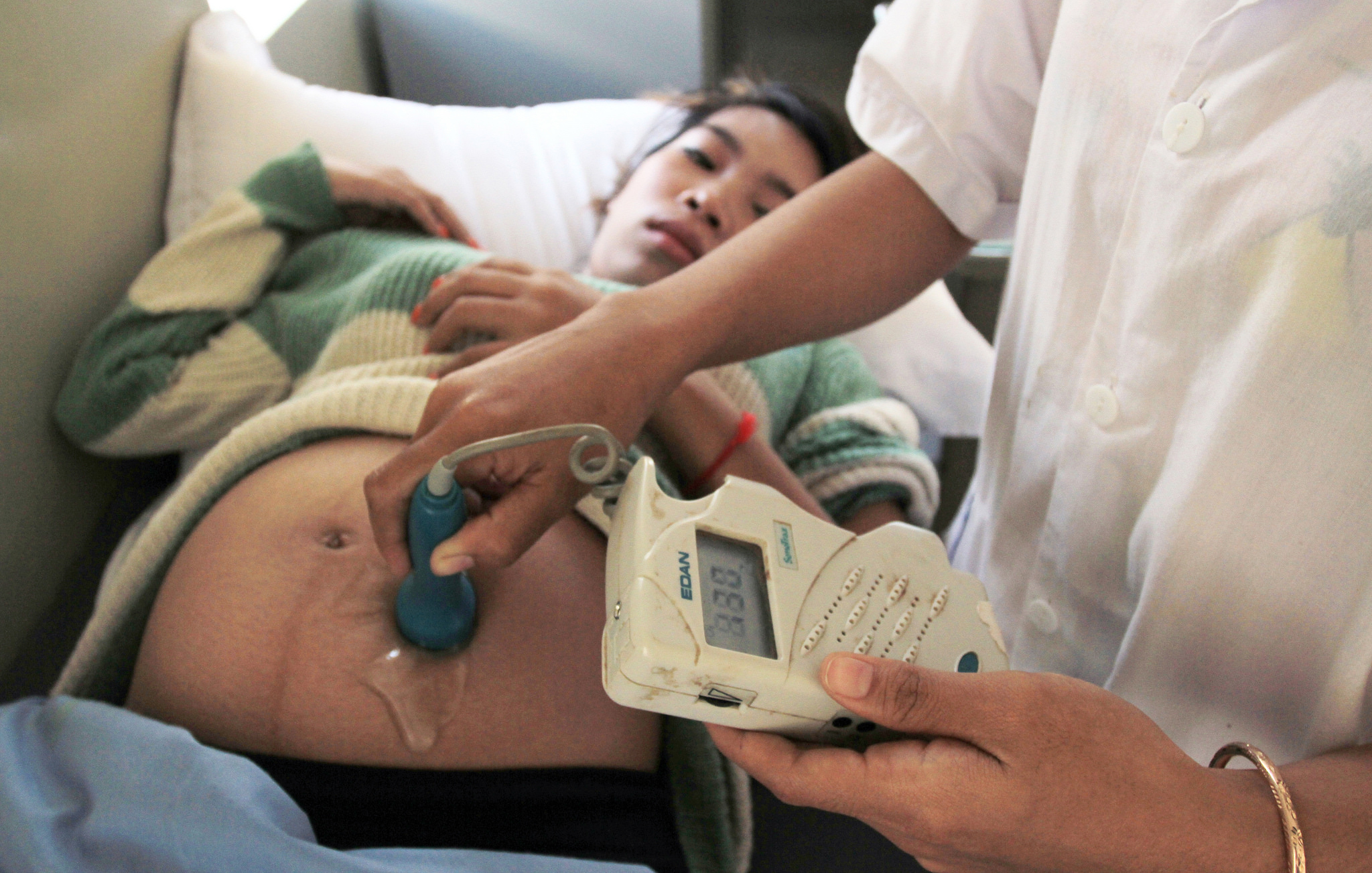ចំនួនម្តាយដែលស្លាប់នៅក្នុងអំឡុងពេលសម្រាលបុត្របានកាត់បន្ថយជិតពាក់កណ្តាលក្នុងរយៈពេលជាងបួនឆ្នាំមកនេះ ពីចំនួន ១៨២ នាក់ នៅឆ្នាំ ២០១១ មកនៅត្រឹម ១០០ នាក់ នៅឆ្នាំ ២០១៥។1 ការស្លាប់ក្នុងចំនោមកុមារក៏បានធ្លាក់ចុះផងដែរ បើទោះជាចំនួននេះនៅតែខ្ពស់គួរសម ហើយកម្រិតប្រេវ៉ាឡង់នៃទារកកើតមិនគ្រប់ទម្ងន់ គឺនៅតែខ្ពស់ បើប្រៀបធៀបទៅនឹងបណ្តាប្រទេសជាច្រើនទៀត។

ស្ត្រីមានផ្ទៃពោះទទួលការថែទាំមុនសម្រាលនៅមន្ទីរពេទ្យ ១៦ មករា ស្ថិតក្នុងខេត្តព្រះវិហារ ប្រទេសកម្ពុជា។ រូបថត ដោយ ឆ សុគន្ធា/ធនាគារពិភពលោក នៅថ្ងៃទី ៣០ ខែ មករា ឆ្នាំ ២០១៣។ ក្រោមអាជ្ញារប័ណ្ណ CC BY-NC-ND 2.0។
សុខភាព និងមរណភាពមាតា
អត្រាមរណភាពមាតានៅកម្ពុជា ទាបជាងចំនួនដែលបានប៉ាន់ប្រមាណសម្រាប់ប្រទេសភូមា និងឡាវ ប៉ុន្តែតួលេខនៅខ្ពស់ជាងប្រទេសថៃ និងវៀតណាមច្រើនដងទៀត។ ការងារដ៏ស្វិតស្វាញត្រូវបានមើលឃើញថា មានភាពល្អប្រសើរយ៉ាងខ្លាំងនៅក្នុងរយៈពេល ១៥ ឆ្នាំ ចុងក្រោយនេះ។
នេះគឺការប៉ាន់ប្រមាណរបស់ មូលនិធិអង្គការសហប្រជាជាតិកុមារអន្តរជាតិ (យូណេសេហ្វ) សម្រាប់ឆ្នាំ ២០១៣។2
| ប្រទេស | ការប៉ាន់ប្រមាណនៃមរណភាពមាតាក្នុងចំនោម មនុស្ស ១០០,០០០ នាក់ | ចំនូននៃការស្លាប់របស់មាតា |
| កម្ពុជា | ១៧០ | ៦៧០ |
| មីយ៉ាន់ម៉ា | ២០០ | ១៩០០ |
| ថៃ | ២៦ | ១៨០ |
| ឡាវ | ២២០ | ៤០០ |
| វៀតណាម | ៤៩ | ៦៩០ |
នៅក្នុងឆ្នាំ ១៩៩០ អត្រាមរណភាពមាតា គឺ ១.២០០ ដែលអត្រានេះបានធ្លាក់ចុះត្រឹម ៨៦ ភាគរយ នៅក្នុងរយៈពេល ១៥ ឆ្នាំចុងក្រោយនេះ (អត្រាសម្រាប់តំបន់អាស៊ីទាំងមូល គឺ ៣៥០ នៅឆ្នាំ ១៩៩០ និង ១៤០ នៅឆ្នាំ ២០១៣ ធ្លាក់ចុះ ៦១ ភាគរយ)។3
ការផ្លាស់ប្តូរដ៏ធំនេះ ឆ្លុះបញ្ចាំងពីការរីកចម្រើនដ៏គួរឱ្យកត់សម្គាល់នៅក្នុងសេវាសុខាភិបាលជាតិដែលផ្តល់ជូនសម្រាប់ស្ត្រីជាម្តាយ ហើយវាគឺកំពុងតែបន្តទៅមុខ។ លទ្ធផលជាបឋមនៃប្រជាសាស្ត្រកម្ពុជា និងការវាស់ស្ទង់សុខភាពក្នុងឆ្នាំ ២០១៤ ដែលបានចេញផ្សាយកាលពីដើមឆ្នាំ ២០១៥ បង្ហាញថា៖
- ៨៩ ភាគរយនៃស្ត្រីមានផ្ទៃពោះ នៅឆ្នាំ ២០១៤ បានសម្រាលបុត្រជាមួយពេទ្យឯកទេស ដែលចំនួននេះកើនពី ៧១ ភាគរយ នៅឆ្នាំ ២០១០។
- ៨៣ ភាគរយនៃទារក ត្រូវបានផ្តល់កំណើតនៅមណ្ឌលសុខភាព នៅឆ្នាំ ២០១៤ ដែលចំនួននេះកើនពី ៥៤ ភាគរយ នៅឆ្នាំ ២០១០។4
ការធ្វើឱ្យប្រសើរឡើងនៃសុខភាពមាតា គឺផ្នែកមួយនៃគោលដៅអភិវឌ្ឍន៍សហស្សវត្សរ៍(គោលដៅទី ៥)។ គោលដៅពីរដើម្បីសម្រេចឱ្យបាននូវគោលដៅអភិវឌ្ឍន៍សហស្សវត្សរ៍ទី ៥នោះ គឺការកាត់បន្ថយអត្រាមរណភាពមាតា ឲ្យបាន ៧៥ ភាគរយ ចន្លោះឆ្នាំ ១៩៩០ និងឆ្នាំ ២០១៥ (ជាគោលដៅមួយដែលប្រទេសកម្ពុជាសម្រេចបាន) និងការសម្រេចបានជាសកលនូវការទទួលបានសេវាសុខភាពបន្តពូជនៅត្រឹមឆ្នាំ ២០១៥។
ស្ត្រីមានផ្ទៃពោះនៅប្រទេសកម្ពុជា ជាញឹកញាប់តែងតែរងគ្រោះដោយសារកង្វះអាហារូបត្ថម្ភ។ ជាឧទាហរណ៍ អ្នកសិក្សាស្រាវជ្រាវជាច្រើន បានរកឃើញថា យ៉ាងហោចណាស់ ពាក់កណ្តាលនៃស្តី្រមានផ្ទៃពោះទាំងនោះ មានជំងឺស្លេកខ្លាំងដោយសារការចុះថយនៃគោលិកាក្រហមរបស់ឈាម។5 ប៉ះពាល់នេះ មិនត្រឹមតែមានទៅលើសុខភាពរបស់មាតាប៉ុណ្ណោះទេ តែវាក៏ប៉ះពាល់ដល់សុខភាពរបស់កុមារផងដែរ ជាមួយនឹងភាពទាក់ទងគ្នារវាងជំងឺមាតា និងទារកមិនគ្រប់ខែ និងមិនគ្រប់ទម្ងន់។6
ប្រទេសកម្ពុជា មានអត្រាប្រេវ៉ាឡង់នៃទារកមិនគ្រប់ទម្ងន់ខ្ពស់បំផុត ក្នុងចំនោមប្រទេសប្រមាណ ៣០ ដែលត្រូវបានគេសិក្សានៅក្នុងរបាយការណ៍វេជ្ជសាស្ត្រឆ្នាំ ២០១៤ ដោយមជ្ឈមណ្ឌលជាតិសម្រាប់សុខភាពកុមារ និងការអភិវឌ្ឍរបស់ប្រទេសជប៉ុន។7 ប្រហែល ១៩ ភាគរយនៃកំណត់ត្រានៃការសម្រាលនៅមន្ទីរពេទ្យ គឺជាទារកតូចមិនគ្រប់គីឡូ (អាស្រ័យលើចំនួនសប្តាហ៍ដែលពួកគេនៅក្នុងផ្ទៃ)។ ទារកសម្រាលមុនពេលកំណត់ ឬទារកកើតមិនគ្រប់ទម្ងន់មានទំនាក់ទំនងជាមួយនឹងជំងឺដង្កាត់នានា។ ប្រមាណ ៣១ ភាគរយនៃទារកដែលកើតមុនកំណត់ និងតូចពេកនៅក្នុងមន្ទីរពេទ្យកម្ពុជា កើតចេញពីម្តាយដែលមានជំងឺ ជាឧទាហរណ៍ ជំងឺត្រៀមព្រាយក្រឡាភ្លើង (ស្ថានភាពដែលសម្ពាធឈាមឡើងខ្ពស់) ឬ ជំងឺព្រាយក្រឡាភ្លើងធ្ងន់ធ្ងរ។8
ផែនការយុទ្ធសាស្រ្តអភិវឌ្ឍន៍ជាតិ ឆ្នាំ២០១៤-២០១៨ របស់រដ្ឋាភិបាលកម្ពុជា បានឱ្យដឹងថា នៅក្នុងឆ្នាំ ២០១៣៖
- ២ភាគរយ នៃស្រ្តីមានគត៌ បានទៅរកការថែទាំផ្ទៃពោះ
- ៨៤ ភាគរយ បានទទួលថ្នាំគ្រាប់ជាតិដែក និងហ្វូលីក អាស៊ីត
- ៧៨ភាគរយ នៃស្ត្រីផ្ទុកមេរោគហ៊ីវក្នុងពេលមានគរ៌ បានទទួលការផ្តល់ថ្នាំប្រឆាំងសម្រាប់ការពារការចម្លងវីរុសពីម្តាយទៅកូន។
យ៉ាងណាមិញ មានតែ ៣៤ ភាគរយប៉ុណ្ណោះដែលបានរាយការណ៍ថា បានប្រើប្រាស់ការពន្យារកំណើតបែបទំនើប។
គោលដៅផែនការអភិវឌ្ឍន៍ជាតិ ២០១៤-២០១៨ បានឱ្យដឹងទៀតដែរថា នៅក្នុងឆ្នាំ ២០១៣ ការសម្រាល ៣.២ ភាគរយ គឺតាមរយៈការវះកាត់។
មរណភាពកុមារ
គោលដៅអភិវឌ្ឍន៍សហស្សវត្សរ៍មួយទៀត (គោលដៅទី ៤) គឺសំដៅកាត់បន្ថយមរណភាពកុមារ (ហើយជាពិសេស កាត់បន្ថយអត្រាមរណៈកុមារអាយុក្រោម៥ឆ្នាំ ឲ្យបាន ២ភាគ៣ នៅត្រឹមឆ្នាំ ២០១៥)។ ភាពល្អប្រសើរដ៏គួរអោយកត់សម្គាល់ត្រូវបានកើតឡើង។9
អត្រាមរណភាពរបស់ទារក (កុមារដែលស្លាប់មុនមានអាយុ មួយឆ្នាំ) មានការប្រែប្រួលបន្តិចបន្តួចនៅក្នុង ទសវត្សរ៍ឆ្នាំ១៩៩០10 ប៉ុន្តែនៅរវាង ឆ្នាំ ២០០០ និង ឆ្នាំ២០១០ អត្រានេះបានធ្លាក់ចុះពី ៩៥ មក ៤៥ នាក់ប៉ុណ្ណោះ ក្នុងចំនោមកំណើតរស់រាន ១,០០០។11 វឌ្ឍនភាពនេះកើតមានដោយមានការចូលរួមចំណែកពីជោគជ័យនៃកម្មវិធីចាក់ថ្នាំបង្ការ និងការលើកកម្ពស់ការបំបៅដោះកូន និងកត្តាមួយទៀត ចំនួនដូចជា ការកាត់បន្ថយភាពក្រីក្រ ការអប់រំកាន់តែល្អប្រសើរ និងផ្លូវថ្នល់ល្អជាងមុន។
ប្រមាណជា ១៧ ភាគរយនៃការស្លាប់របស់កុមារក្រោមអាយុ ៥ ឆ្នាំ គឺបណ្តាលមកពីជំងឺរលាកទងសួត ខណៈដែលជំងឺរលាកស្រោមខួរ មានប្រមាណជា ១.៤ ភាគរយ នេះបើយោងតាមទិន្នន័យក្នុងឆ្នាំ ២០១៣ របស់អង្គការសុខភាពពិភពលោក។12 ចាប់តាំងពីខែ មករា ឆ្នាំ២០១៥ មក កុមារដែលមានអាយុក្រោមមួយឆ្នាំ អាចទទួលបានការចាក់វ៉ាក់សាំងការពារជំងឺរលាកទងសួត (PCV) ដែលជាការផ្តល់សេវាឥតគិតថ្លៃ នៅតាមមណ្ឌលសុខភាពនានា និងសេវាចាក់ថ្នាំបង្ការផ្សេងទៀត។
យោងតាមផែនការយុទ្ធសាស្រ្តអភិវឌ្ឍន៍ជាតិ ២០១៤-២០១៨ កុមារអាយុក្រោមមួយឆ្នាំ ប្រមាណជា ៩០ ភាគរយ នៅក្នុងឆ្នាំ២០១៣ បានទទូលការចាក់ថ្នាំបង្ការជំងឺកញ្ជ្រិល។
នៅខែមីនា ឆ្នាំ២០១៥ ប្រទេសកម្ពុជាត្រូវបានផ្ទៀងផ្ទាត់ដោយគណៈកម្មាធិការផ្ទៀងផ្ទាត់ជំងឺកញ្ជ្រឹលប្រចាំតំបន់ថា ជាប្រទេសដែលបានលុបបំបាត់ជំងឺកញ្ជ្រិល។13
ចំណាំ៖ ការប៉ាន់ប្រមាណសម្រាប់ស្ថិតិសុខភាពមានការប្រែប្រួលខុសគ្នាទៅតាមប្រភព ហើយវាមិនមែនជារឿងចម្លែកទេក្នុងការស្វែងរកឃើញស្ថិតិដែលមានភាពខុសគ្នាច្រើនជាង ១០ ភាគរយ រវាងតួលេខ ពីទីភ្នាក់ងារសាកលផ្សេងៗ ឬ រវាងទិន្នន័យរបស់ភ្នាក់ងារ និងទិន្នន័យរបស់រដ្ឋាភិបាល។
ធ្វើបច្ចុប្បន្នភាពចុងក្រោយ៖ ១៩ ធ្នូ ២០១៥
ឯកសារយោង
- 1. សែន ដាវីដ. “ស្រ្តី ១០០ ស្លាប់ក្នុងឆ្នាំ ២០១៥ អំឡុងពេលពរពោះនិងឆ្លងទន្លេ”. កាសែតភ្នំពេញប៉ុស្តិ៍, ចុះផ្សាយថ្ងៃទី ១៨ ខែ ធ្នូ ឆ្នាំ ២០១៥។ http://bit.ly/1QQB88F
- 2. ទិន្នន័យអង្គការយូនីសេហ្វ (UNICEF). “សុខភាពមាតា.” ចូលអានថ្ងៃទី ២២ ខែ ឧសភា ឆ្នាំ ២០១៥។ http://data.unicef.org/maternal-health/maternal-mortality
- 3. ដូចឯកសារយោងខាងដើម។
- 4. សែន ដាវីត និង Sarah Taguiam. “ការជម្រុញថ្មីសម្រាប់សុខភាពមាតា”។ កាសែតដឹភ្នំពេញប៉ុស្តិ៍, ចុះថ្ងៃទី ២៣ ខែ កុម្ភៈ ឆ្នាំ ២០១៥។http://www.phnompenhpost.com/new-push-maternal-health
- 5. អង្គការសុខភាពពិភពលោក. “ព័ត៌មានទិន្នន័យតាមប្រទេស ស្តីពីសុខភាពពេលពពោះ និងក្រោយកំណើត”។ ចូលអានថ្ងៃទី ២២ ខែ ឧសភា ឆ្នាំ ២០១៥។ http://www.who.int/maternal_child_adolescent/epidemiology/profiles/maternal/khm.pdf ។ Christopher V. Charles. ត្រីដែក៖ បច្ចេកទេសផ្តល់ជីវជាតិបន្ថែមថ្មីដើម្បីបង្ការជំងឺខ្វះឈាមក្រហមសម្រាប់ស្ត្រីនៅទីជនបទនៃប្រទេសកម្ពុជា. និក្ខេបបទបណ្ឌិត. សាកលវិទ្យាល័យ Guelph , ខែមេសា ឆ្នាំ ២០១២។
- 6. Laignee Barron. “ទម្ងន់ទារកទើបនឹងកើតស្ថិតនៅក្នុងកម្រិតប្រៀបធៀបទាប”។ កាសែតភ្នំពេញប៉ុស្តិ៍, ចុះថ្ងៃទី ២០ ខែ តុលា ឆ្នាំ ២០១៤។ http://www.phnompenhpost.com/national/newborns-weigh-comparably-low-levels
- 7. ដូចឯកសារយោងខាងដើម។
- 8. ដូចឯកសារយោងខាងដើម។
- 9. អង្គការយូណីសេស (Unicef). “សុខភាពមាតា ទារក កុមារ និងអាហារូបត្ថម្ភ។ ចូលអានថ្ងៃទី ២២ ខែ ឧសភា ឆ្នាំ ២០១៥។ http://www.unicef.org/cambodia/6.Maternal.pdf
- 10. ធនាគារពិភពលោក. “អត្រាមរណភាពកុមារ (ក្នុងចំនោមកំណើតនៅរស់ ១,០០០) ឆ្នាំ ១៩៦០-២០១៥.”។ ចូលអានថ្ងៃទី ២២ ខែ ឧសភា ឆ្នាំ ២០១៥។ http://data.worldbank.org/indicator/SP.DYN.IMRT.IN?page=
- 11. អង្គការយូណីសេស (Unicef). “សុខភាពមាតា ទារក កុមារ និងអាហារូបត្ថម្ភ។ ចូលអានថ្ងៃទី ២២ ខែ ឧសភា ឆ្នាំ ២០១៥។ http://www.unicef.org/cambodia/6.Maternal.pdf
- 12. សែន ដាវីត និង Sarah Taguiam, “វត្តមានថ្នាំវ៉ាក់ស៊ាំងថ្មី”។ កាសែតភ្នំពេញប៉ុស្តិ៍, ចុះថ្ងៃទី ១៦ ខែ មករា ឆ្នាំ ២០១៥។ http://www.phnompenhpost.com/national/new-vaccines-available ។
- 13. អង្គការសុខភាពពិភពលោក. “ប្រទេសប្រ៊ុយណេ, កម្ពុជា, ជប៉ុន សម្រេចបានការលុបបំបាត់ជំងឺកញ្ជ្រិល.”។ សេចក្តីប្រកាសព័ត៌មាន ថ្ងៃទី ២៧ ខែមីនា ឆ្នាំ ២០១៥។ ចូលអានថ្ងៃទី ២៣ ខែ ឧសភា ឆ្នាំ ២០១៥។ http://www.wpro.who.int/mediacentre/releases/2015/20150327/en/

